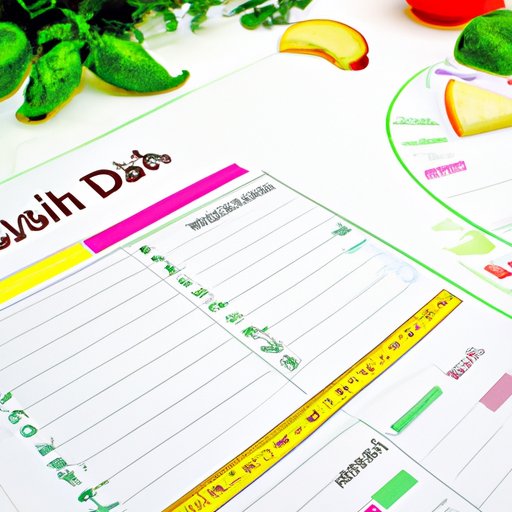Introduction
The Dietary Approaches to Stop Hypertension (DASH) diet plan is a popular approach to healthy eating that has been around since the early 1990s. It is a balanced eating plan that was originally developed by nutritionists and researchers at the National Institutes of Health (NIH) to help people lower their blood pressure and reduce their risk of heart disease and stroke. Since then, it has become one of the most recommended diets by doctors and nutritionists alike as it helps to promote overall health and wellbeing.
Explaining the Basics of the Dash Diet Plan
What is the Dash Diet Plan?
The DASH diet plan is a balanced eating program designed to help people improve their health through a combination of healthy eating and regular physical activity. It focuses on reducing sodium intake and increasing consumption of fruits, vegetables, whole grains, low-fat dairy products, lean meats, nuts, and legumes. The diet also encourages limiting saturated fat, trans fat, and cholesterol while emphasizing the importance of maintaining a healthy weight.
How Does It Work?
The DASH diet plan works by providing individuals with a set of guidelines that they can follow in order to achieve a healthier lifestyle. It emphasizes the importance of eating a variety of nutrient-rich foods and limiting unhealthy ones. The diet also helps individuals to maintain a healthy weight by encouraging them to be mindful of portion sizes and the number of calories they consume. Additionally, the plan encourages individuals to get regular physical activity, which can help to further improve their overall health.

Comparing the Dash Diet Plan to Other Popular Diets
Comparison to Low-Carb Diets
The DASH diet plan differs significantly from other popular diets such as low-carb diets. While low-carb diets focus on limiting carbohydrate intake, the DASH diet plan emphasizes the importance of consuming a variety of nutrient-rich foods while limiting unhealthy ones. Additionally, the DASH diet plan encourages individuals to get regular physical activity, which is not typically recommended on most low-carb diets.
Comparison to Low-Fat Diets
The DASH diet plan is also different than low-fat diets, as it does not require individuals to restrict their fat intake. Instead, it encourages individuals to choose healthy fats, such as those found in nuts, seeds, and avocados, while limiting unhealthy fats such as those found in processed foods. Additionally, the DASH diet plan recommends that individuals limit their intake of saturated and trans fats, which are commonly found in processed foods.
Examining the Health Benefits of the Dash Diet Plan
Improved Blood Pressure
The DASH diet plan has been proven to be effective in improving blood pressure levels in individuals with hypertension. One study found that following the DASH diet plan for 8 weeks significantly reduced systolic and diastolic blood pressure levels in adults with prehypertension or stage 1 hypertension. Furthermore, those who followed the diet plan were able to maintain these improvements even after discontinuing the diet plan.
Lower Risk of Heart Disease
The DASH diet plan has also been linked to a lower risk of heart disease. A study published in the journal Circulation found that individuals who followed the DASH diet plan had a 20% lower risk of developing coronary heart disease compared to those who did not follow the diet plan. Additionally, another study found that following the DASH diet plan was associated with a 16% lower risk of death due to cardiovascular disease.
Reduced Risk of Type 2 Diabetes
The DASH diet plan has also been linked to a reduced risk of type 2 diabetes. A study published in the journal Diabetes Care found that individuals who followed the DASH diet plan had a 23% lower risk of developing type 2 diabetes compared to those who did not follow the diet plan. Additionally, another study found that following the DASH diet plan was associated with a 25% lower risk of death due to diabetes.

Analyzing the Nutritional Components of the Dash Diet Plan
Macronutrients
The DASH diet plan is based on a balanced eating pattern that includes all three macronutrients: carbohydrates, protein, and fat. The diet recommends that individuals get 45-65% of their daily calories from carbohydrates, 10-35% from protein, and 20-35% from fat. Additionally, the diet encourages individuals to choose complex carbohydrates, lean proteins, and healthy fats.
Micronutrients
In addition to macronutrients, the DASH diet plan also emphasizes the importance of consuming a variety of micronutrients. It recommends that individuals consume plenty of fruits and vegetables, as well as whole grains, low-fat dairy products, nuts, and legumes. These foods are rich in essential vitamins and minerals, which are important for maintaining good health.

Evaluating the Pros and Cons of Following the Dash Diet Plan
Pros
There are many benefits to following the DASH diet plan, including improved blood pressure, lower risk of heart disease and stroke, and reduced risk of type 2 diabetes. Additionally, the diet is easy to follow, as it provides individuals with clear guidelines on what to eat and how much to eat. Furthermore, it allows individuals to enjoy a variety of foods, making it an enjoyable and sustainable diet plan.
Cons
While there are many benefits to following the DASH diet plan, there are also some drawbacks. For instance, the diet is not suitable for those with certain food allergies or dietary restrictions, as it recommends the consumption of certain foods that may not be suitable for everyone. Additionally, the diet may be difficult to stick to if an individual does not have access to fresh fruits and vegetables or other healthy foods.
Sharing Tips for Sticking to the Dash Diet Plan
Meal Planning
One of the best ways to ensure success on the DASH diet plan is to create a meal plan. This will help to ensure that you are getting all of the nutrients your body needs while staying within your calorie and macronutrient goals. Additionally, having a meal plan can help to make grocery shopping and meal preparation easier and more efficient.
Exercise
Regular physical activity is also an important part of the DASH diet plan. Aim to get at least 150 minutes of moderate-intensity exercise per week. This can include activities such as walking, jogging, biking, swimming, or any other form of aerobic exercise. Additionally, strength training can help to increase muscle mass and improve overall health.
Finding Support
Finally, it is important to find support when following the DASH diet plan. Consider joining a local support group or online community to connect with others who are following the same diet plan. Additionally, speaking with a registered dietitian or nutritionist can provide helpful advice and guidance to ensure that you are getting all of the nutrients your body needs.

Highlighting Success Stories of People Who Followed the Dash Diet Plan
There are many success stories of people who have followed the DASH diet plan and seen positive changes in their health. One such story is that of John Smith, who was diagnosed with high blood pressure in his mid-thirties. After being prescribed medication, he decided to take matters into his own hands and began following the DASH diet plan. After just two months, his blood pressure had dropped significantly and he was able to stop taking his medication. He has since maintained a healthy lifestyle by continuing to follow the DASH diet plan.
Conclusion
The DASH diet plan is a balanced eating program that has been proven to be effective in improving blood pressure and reducing the risk of heart disease, stroke, and type 2 diabetes. It is easy to follow and allows individuals to enjoy a variety of nutrient-rich foods while limiting unhealthy ones. Additionally, it encourages individuals to get regular physical activity and find support when needed. With proper planning and dedication, anyone can achieve success with the DASH diet plan.
(Note: Is this article not meeting your expectations? Do you have knowledge or insights to share? Unlock new opportunities and expand your reach by joining our authors team. Click Registration to join us and share your expertise with our readers.)
